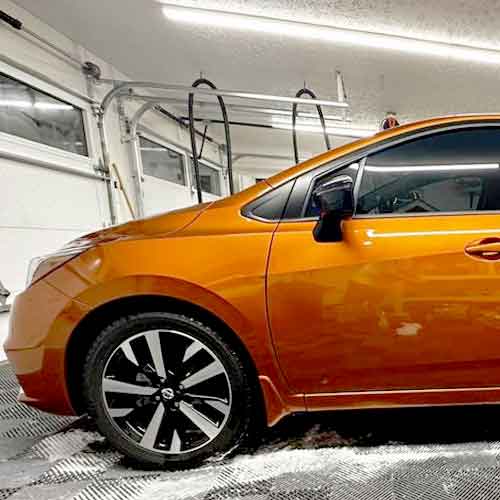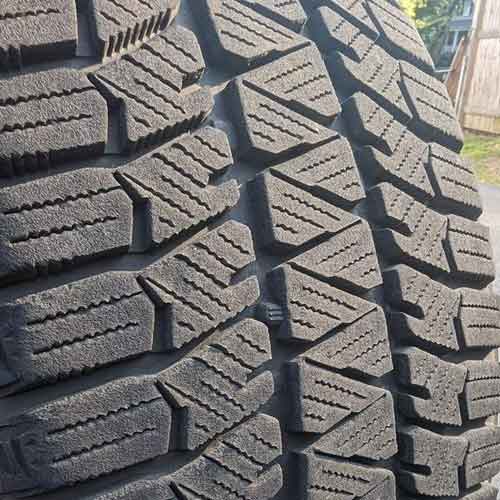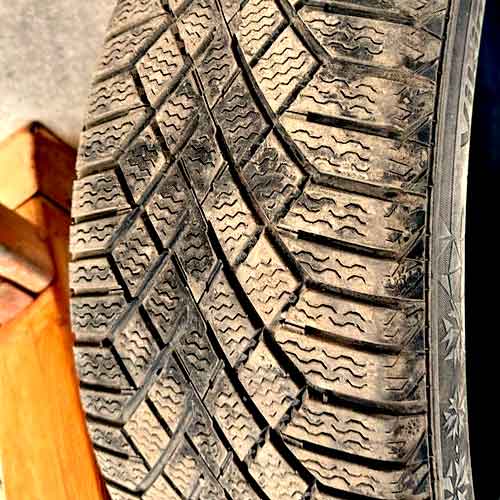A chilling duel ensues as Continental VikingContact 7, known for its great fuel efficiency, squares up against the Bridgestone Blizzak WS90, famed for its consistent winter performance. Who will weather the storm to reign supreme?

Table of Contents
Tire Sizes
The Bridgestone Blizzak WS90 comes in 52 total sizes in 15 to 19 inches (wheels) with following specs.
- Speed ratings: T or H.
- Load ratings: SL or XL.
- Tread depth: 11 or12/32″.
- Weight: 17 to 29 lbs.
- Tread warranty: None.
Review this tire in greater detail: https://snowytires.com/bridgestone-blizzak-ws90-review/
On the other side, the Continental VikingContact 7 comes in
- Speed ratings: H and T.
- Load ratings: SL and XL (mostly).
- Tread depth: 10/32″ on all.
- Weight: 14 to 35 lbs.
Review this tire in greater detail: https://snowytires.com/continental-vikingcontact-7-review/
Tread Appearance
Showcasing a robust and intricate directional tread design, the Bridgestone Blizzak WS90 is a testament to superior tire engineering, no doubt about that. Let’s look at its tread pattern in more details.

So this tire’s tread is dominated by three marked ribs, with the central rib acting as a continuous band, (as it’s not broken up all the way, with voids).
This rib is punctuated with wave-like sipes, and rectilinear, thicker slits, which meet with the in-groove notches.
Moreover, as these notches have V shaped openings (facing both sides, laterally), you further get enhancements to the overall bite.
Moving towards shoulders, the lugs here are elongated and carry multiple tread features too.
They feature notches of both lateral and longitudinal orientations, along with multiple wave-like sipes of various angles.
Note, that these lugs are not divided up all the way, by the longitudinal slits you see, so these act as in-groove notches.
On the other hand, Continental VikingContact 7 features a more packed up tread design, though its also directional.

So, this tread can be understood by considering it’s two parts, central area, and shoulders.
The central part of the tread has very blocky, squared-off lugs.
These blocks have numerous wave-like sipes, and chamfered edges to them.
And as they are sitting on secondary rubber layers (acting as reinforced foundations), the gaps between these blocks act as in-groove notches.
Moving towards the tread extremities, these (shoulder) blocks here are elongated, and run in pairs (joined up with each other).
And besides forming sharper edges, these blocks have thicker, and prominent siping pattern on them.
And yes, one more thing, they are separated form each other with wide lateral voids, which aid a lot in tread’s self cleaning.
Snow Performance
In assessing performance on fluffy snow, while both tires showcase notable competence, the Continental VikingContact 7 stands out as the more superior choice. And a closer examination of its tread design reveals why.
The VikingContact 7 is basically characterized by a larger count of tread voids, predominantly in the form of in-groove notches.
These voids skillfully trap snow particles, enhancing snow to snow contact. Basically the trapped snow meets with the ground as the tire rolls, and as snow sticks better on itself, compared to rubber, you get an enhanced gripping efficacy.
In addition to this, the tire provides you with sweeping V-shaped lugs that excel in clearing away heavy snow, thereby enabling forward momentum (by throwing the snow backwards, as the tire rolls).
This unique feature contributes to the tire’s marginally superior acceleration times.
On the contrary, the Bridgestone Blizzak WS90 delivers somewhat lesser efficiency in braking and handling. The design of this tire is relatively closed-off, with a continuous central rib and narrower in-groove notches.
Moreover, despite possessing a directional tread pattern, the Blizzak WS90 does not present comprehensive swooping arms like its counterpart.
So it’s not able to paddle through the snow with as much effectiveness.
Ice Performance
On ice, things take the U turn, the Bridgestone Blizzak WS90 gets to provide 6 feet shorter braking distances compared to its counterpart.
And same is the case, when it comes to acceleration, with Blizzak being faster.
So why is that?
Well, that’s because of the tire numerous intricate biters all over the tread.
It’s central rib features slanted incisions of varying width, and these combined with V shaped notches (on this rib), you get superior longitudinal ice traction.
And aiding to that, are it’s multi-angled sipes. If you consider its tread pattern again, you’d note that the sipes has two slanted lateral angles on the rib. This accounts for extra gripping on icy terrains.
Moreover, the tire’s shoulder lugs offer incisions/biting edges in both lateral and longitudinal directions, supply you with a great grip form all sides. And yes, here the sipes also have two different angles to them as well (just like in the middle part of the tread).
These shoulder blocks basically provide the tire with superior handling abilities, showcasing smaller handling times and faster steering feedback.
Continental VikingContact 7 on the other hand, as you can see, comes with wider tread voids, which aren’t able to grip in to the ice with as much efficiency, as its counterpart.
Moreover, the tire is also missing with notches, and multi-angled siping, on both central and shoulder lugs, so it comes out with a longer average braking distance and handling time.
Though subjectively, its steering feedback is almost the same as its peer.
Wet Traction
Wet traction relies primarily on two aspects: the tread design and the composition of the rubber. And these tell about two things grip and hydroplaning resistance.
In regard to grip, although both tires feature ample siping and soft tread rubbers, the Bridgestone Blizzak WS90 still emerges as the front-runner.
So why is that? Well, this can be attributed to the tire’s extensive array of rectilinear and interlocking sipes.
These offer much better water absorbing capabilities, allowing for superior wet grip. Their multi-angled structures allow for superior cornering and braking abilities, as the sipes get to be parallel to the tire’s direction of the motion.
On the other side, as the Continental VikingContact 7 only features laterally oriented sipes, it falls short in providing as much of the overall traction abilities. So you get longer wet braking distances and handling times with this tire (on average).
But in the other half of overall wet traction, hydroplaning resistance, the tire does much better.
With it’s wider grooves and swooping arms, the tire allows much better float speeds (on average), in both curved and straight aqua tests.
And its interconnected web of grooves efficiently disperses water in all directions, allowing for much better resistance to aquaplaning overall (in comparison).
Dry Traction
The effectiveness of dry grip largely hinges on the tire’s surface contact with the ground, with the directional grip and lateral traction being the key determinants.
Here, the Blizzak WS90, with its continuous central rib, holds an advantage.
This is because the tire’s design ensures a much better, and constant surface contact as it moves straight, (primarily on highways). And this in turn contributes to shorter braking distances and quicker acceleration times in tests.
It continuous running rib gets the most credit here, as well, as closed up surrounding lugs, though those help in handling. Though that has more to do with the tire’s lighter weight.
You see, the heavier structure of the VikingContact 7 is a critical element compromising its performance.
This increased weight basically triggers greater lug movement, as the tire takes corners, reducing steering feedback and resulting in longer handling times in comparison to the Blizzak.
Comfort Levels
Comfort in a tire can be largely attributed to factors such as road noise and vibration absorption. These attributes are largely influenced by the tire’s construction, the materials used, the tread pattern, and the overall sidewall design (which basically tell cornering smoothness).
And since I’ve covered the cornering part above, I’d look at the other two here.
In terms of noise, although you can’t expect a lot from winter tires, the Blizzak WS90 still takes a bigger piece of the pie.
This is mainly because the tire’s tread is less voided, and this feature plays a critical role as noise primarily results from air particles colliding with the tread walls.
On the other side, the Continental VikingContact 7, although gets to be louder, it still features better performance in the other half of overall comfort, as the tire offers marginally superior shock absorption for a smoother ride over bumps.
So overall considering all of the above, both tires are on par with each other.
Fuel Economy
Fuel consumption in tires is closely linked to their adhesion to the road surface and the overall structural weight, both of which are areas where the VikingContact 7 could improve.
This is because this tire’s significant weight basically increases its overall rolling resistance, while its broader tread voids lead to heightened friction as the tire rolls over the tar surfaces.
On the other side, the Blizzak WS90 being lighter puts less pressure on the surface, thereby reducing overall friction.
And as its tread comes equipped with longitudinally aligned ribs, which are streamlined with the tire’s rolling straight, it faces less overall hurdles in maneuvering, thereby conserving energy and enhancing fuel economy.
Tread Life
Tread longevity is greatly impacted by rolling resistance, at least when it comes to these two tires.
And in this regard, the Blizzak is taking the lead.
The tire with its lighter weight basically exerts relatively smaller force/pressure on the tread blocks, as they rub against the road. This consequently produces less friction and slows down the rate of rubber degradation.
On the flip side, the Continental VikingContact 7, while heavier, concentrates this extra load on a smaller rubber surface due to its wider tread voids.
This leads to each lug bearing more weight, accelerating tread wear and reducing its overall lifespan.
However, it’s important to note that the difference in performance between the two tires is relatively minor, which explains why neither offers any warranties.
To Conclude
In the assessment of snow performance, the Continental VikingContact 7, with its unique tread design and larger count of tread voids, demonstrates superior capabilities for gripping and clearing away snow.
However, in icy conditions, the Bridgestone Blizzak WS90 surpasses its counterpart, thanks to its intricate biters, slanted incisions, and multi-angled sipes offering greater traction and handling.
On tar, the Blizzak takes the lead in gripping area, though the VikingContact 7 exhibits superior hydroplaning resistance.
But overall Blizzak Ws90 is what you’d want, as the tire offer slightly superior fuel and tread economy, and is quieter.